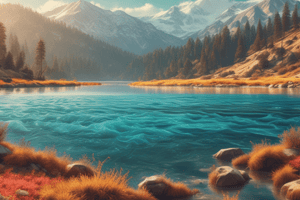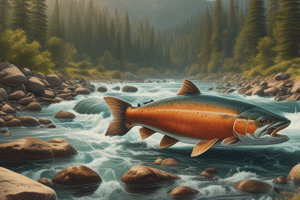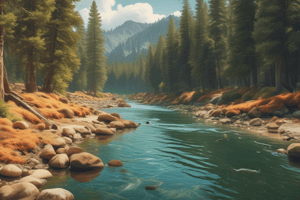Podcast
Questions and Answers
What characteristic of alluvial fans supports more vegetation compared to surrounding areas?
What characteristic of alluvial fans supports more vegetation compared to surrounding areas?
- Better soil and water availability (correct)
- Higher elevation
- Presence of stones
- Consistent sunlight exposure
Which strategy describes annual plants that remain dormant until favorable conditions arise?
Which strategy describes annual plants that remain dormant until favorable conditions arise?
- Evade
- Allelopathy
- Escape (correct)
- Endure
Which adaptation is exhibited by the Desert Tortoise to conserve water?
Which adaptation is exhibited by the Desert Tortoise to conserve water?
- Mating during rainy season
- Underground swimming
- Large body size
- Collecting rainwater (correct)
Which of the following plants is known for its longevity and drought adaptations?
Which of the following plants is known for its longevity and drought adaptations?
What role do biological soil crusts (biocrusts) play in desert ecosystems?
What role do biological soil crusts (biocrusts) play in desert ecosystems?
What is a watershed defined as?
What is a watershed defined as?
What is the primary ecological role of riparian vegetation?
What is the primary ecological role of riparian vegetation?
Which river is the longest in California?
Which river is the longest in California?
What significant challenge do dams present for salmon in California rivers?
What significant challenge do dams present for salmon in California rivers?
What benefit do high river flows provide to aquatic habitats?
What benefit do high river flows provide to aquatic habitats?
What effect do rivers have on agricultural irrigation?
What effect do rivers have on agricultural irrigation?
Which of the following rivers is designated as 'Wild and Scenic'?
Which of the following rivers is designated as 'Wild and Scenic'?
Which of the following best describes anadromous fish?
Which of the following best describes anadromous fish?
What is the primary ecological benefit of rivers like the Merced River having a Wild and Scenic designation?
What is the primary ecological benefit of rivers like the Merced River having a Wild and Scenic designation?
Which of the following beach types is formed specifically at river mouths?
Which of the following beach types is formed specifically at river mouths?
What primarily drives sand movement along California's coastline?
What primarily drives sand movement along California's coastline?
Why are beaches considered dynamic environments?
Why are beaches considered dynamic environments?
Which human modification is most likely to limit sediment supply to beaches?
Which human modification is most likely to limit sediment supply to beaches?
What role does wrack play in beach ecosystems?
What role does wrack play in beach ecosystems?
What is a significant threat to the Coastal Sage Scrub ecosystem?
What is a significant threat to the Coastal Sage Scrub ecosystem?
Which characteristic is typical of chaparral ecosystems?
Which characteristic is typical of chaparral ecosystems?
What adaptation allows certain chaparral plants to survive after wildfires?
What adaptation allows certain chaparral plants to survive after wildfires?
Which of the following is NOT a function of coastal dunes?
Which of the following is NOT a function of coastal dunes?
What contributes primarily to the biodiversity found in coastal sage scrub ecosystems?
What contributes primarily to the biodiversity found in coastal sage scrub ecosystems?
What is a significant ecological benefit of beaches?
What is a significant ecological benefit of beaches?
Which of the following is a primary producer in beach ecosystems?
Which of the following is a primary producer in beach ecosystems?
What type of shrubs dominate the coastal sage scrub (CSS) ecosystem?
What type of shrubs dominate the coastal sage scrub (CSS) ecosystem?
Which adaptation helps chaparral plants conserve water?
Which adaptation helps chaparral plants conserve water?
How does the fire regime in the coastal sage scrub ecosystem primarily get shaped?
How does the fire regime in the coastal sage scrub ecosystem primarily get shaped?
What is the primary soil condition found in chaparral habitats?
What is the primary soil condition found in chaparral habitats?
In what types of conditions do Coast Redwoods typically thrive?
In what types of conditions do Coast Redwoods typically thrive?
What is one way Coast Redwoods can regenerate after being damaged?
What is one way Coast Redwoods can regenerate after being damaged?
What adaptation do Coast Redwoods have to deter pests and resist decay?
What adaptation do Coast Redwoods have to deter pests and resist decay?
What type of regeneration primarily occurs in old-growth redwoods?
What type of regeneration primarily occurs in old-growth redwoods?
Which of the following species coexists with Coast Redwoods?
Which of the following species coexists with Coast Redwoods?
What ecological role do redwood forests play regarding biodiversity?
What ecological role do redwood forests play regarding biodiversity?
What percentage of old-growth redwood forests remain due to historical logging?
What percentage of old-growth redwood forests remain due to historical logging?
Which movement led to the establishment of Redwood National Park?
Which movement led to the establishment of Redwood National Park?
Which feature is unique to albino redwoods?
Which feature is unique to albino redwoods?
What ecological service do redwoods provide regarding water regulation?
What ecological service do redwoods provide regarding water regulation?
What ecological benefit does fire provide in montane forests?
What ecological benefit does fire provide in montane forests?
How does prolonged drought primarily affect dense forests?
How does prolonged drought primarily affect dense forests?
Which tree species is noted for its relationship with Clark’s Nutcracker and its adaptations to harsh conditions?
Which tree species is noted for its relationship with Clark’s Nutcracker and its adaptations to harsh conditions?
What is a significant risk caused by fire suppression in montane forests?
What is a significant risk caused by fire suppression in montane forests?
Which characteristic describes the alpine ecosystem?
Which characteristic describes the alpine ecosystem?
What impact does climate change have on treeline elevation?
What impact does climate change have on treeline elevation?
Which of the following animals is noted for adapting to cold, rocky alpine environments?
Which of the following animals is noted for adapting to cold, rocky alpine environments?
What defines California's desert ecosystems?
What defines California's desert ecosystems?
Which of the following describes the Mojave Desert?
Which of the following describes the Mojave Desert?
Which factor is most important for the survival of plants in desert ecosystems?
Which factor is most important for the survival of plants in desert ecosystems?
What feature is characteristic of the subalpine ecosystem?
What feature is characteristic of the subalpine ecosystem?
What type of soils are commonly found in desert ecosystems?
What type of soils are commonly found in desert ecosystems?
Which species is known to have seen a significant rise in population due to conservation efforts?
Which species is known to have seen a significant rise in population due to conservation efforts?
What is the primary reason for the formation of playas in desert environments?
What is the primary reason for the formation of playas in desert environments?
Flashcards
What is a watershed?
What is a watershed?
An area of land where all precipitation drains into a common body of water, like a river, lake, or ocean. Defined by topographical features, such as ridges, that separate drainage areas. All land is part of a watershed.
What is the Sacramento River?
What is the Sacramento River?
The longest river in California, serving northern California, with significant agricultural and industrial uses.
What is the San Joaquin River?
What is the San Joaquin River?
A river in central and southern California that travels through the San Joaquin Valley and merges with the Sacramento River in the Delta. It supports agriculture and contributes to the Delta's unique ecosystem.
What is the Merced River?
What is the Merced River?
Signup and view all the flashcards
What is the influence of snowmelt on rivers?
What is the influence of snowmelt on rivers?
Signup and view all the flashcards
How do riparian plants benefit rivers?
How do riparian plants benefit rivers?
Signup and view all the flashcards
What is an anadromous life cycle?
What is an anadromous life cycle?
Signup and view all the flashcards
What are the pros and cons of dams on rivers?
What are the pros and cons of dams on rivers?
Signup and view all the flashcards
Escape (Plant Strategy)
Escape (Plant Strategy)
Signup and view all the flashcards
Evade (Plant Strategy)
Evade (Plant Strategy)
Signup and view all the flashcards
Endure (Plant Strategy)
Endure (Plant Strategy)
Signup and view all the flashcards
Behavioral and Physiological Adaptations (Animal Strategies)
Behavioral and Physiological Adaptations (Animal Strategies)
Signup and view all the flashcards
Biological Soil Crusts (Biocrusts)
Biological Soil Crusts (Biocrusts)
Signup and view all the flashcards
How dams impact river ecosystems?
How dams impact river ecosystems?
Signup and view all the flashcards
What is the California poppy?
What is the California poppy?
Signup and view all the flashcards
What are Western redbuds?
What are Western redbuds?
Signup and view all the flashcards
What are willows?
What are willows?
Signup and view all the flashcards
What are pocket beaches?
What are pocket beaches?
Signup and view all the flashcards
What are delta beaches?
What are delta beaches?
Signup and view all the flashcards
What are logarithmic spiral beaches?
What are logarithmic spiral beaches?
Signup and view all the flashcards
What are long straight beaches?
What are long straight beaches?
Signup and view all the flashcards
What is a sand budget?
What is a sand budget?
Signup and view all the flashcards
What is coastal erosion?
What is coastal erosion?
Signup and view all the flashcards
What are littoral cells?
What are littoral cells?
Signup and view all the flashcards
What is chaparral?
What is chaparral?
Signup and view all the flashcards
What is Coastal Sage Scrub (CSS)?
What is Coastal Sage Scrub (CSS)?
Signup and view all the flashcards
What are coastal dunes?
What are coastal dunes?
Signup and view all the flashcards
Coastal Sage Scrub (CSS)
Coastal Sage Scrub (CSS)
Signup and view all the flashcards
Chaparral
Chaparral
Signup and view all the flashcards
Coast Redwood Forest
Coast Redwood Forest
Signup and view all the flashcards
Pest and Disease Resistance in Coast Redwoods
Pest and Disease Resistance in Coast Redwoods
Signup and view all the flashcards
Disturbance Adaptations of Coast Redwoods
Disturbance Adaptations of Coast Redwoods
Signup and view all the flashcards
Water Acquisition in Coast Redwoods
Water Acquisition in Coast Redwoods
Signup and view all the flashcards
Reproduction in Coast Redwoods
Reproduction in Coast Redwoods
Signup and view all the flashcards
Fire and Coast Redwood Forests
Fire and Coast Redwood Forests
Signup and view all the flashcards
Coast Redwood Forest Ecology
Coast Redwood Forest Ecology
Signup and view all the flashcards
History and Conservation of Coast Redwood Forests
History and Conservation of Coast Redwood Forests
Signup and view all the flashcards
Montane Forest
Montane Forest
Signup and view all the flashcards
Major Forest Types in Montane Forests
Major Forest Types in Montane Forests
Signup and view all the flashcards
Key Tree Species in Montane Forests
Key Tree Species in Montane Forests
Signup and view all the flashcards
Treeline
Treeline
Signup and view all the flashcards
Alpine Ecosystem
Alpine Ecosystem
Signup and view all the flashcards
Subalpine Ecosystem
Subalpine Ecosystem
Signup and view all the flashcards
Fire's Ecological Benefits
Fire's Ecological Benefits
Signup and view all the flashcards
Fire Suppression Issues
Fire Suppression Issues
Signup and view all the flashcards
California Spotted Owl
California Spotted Owl
Signup and view all the flashcards
Black-Backed Woodpecker
Black-Backed Woodpecker
Signup and view all the flashcards
Fisher and Northern Flying Squirrel
Fisher and Northern Flying Squirrel
Signup and view all the flashcards
Drought and Beetles
Drought and Beetles
Signup and view all the flashcards
Zombie Forests
Zombie Forests
Signup and view all the flashcards
Great Basin Desert
Great Basin Desert
Signup and view all the flashcards
Mojave Desert
Mojave Desert
Signup and view all the flashcards
Colorado Desert
Colorado Desert
Signup and view all the flashcards
Factors Influencing Desert Ecosystems
Factors Influencing Desert Ecosystems
Signup and view all the flashcards
Playas
Playas
Signup and view all the flashcards
Study Notes
California Rivers
- Rivers distribute water from precipitation and snowmelt to forests, grasslands, wetlands, and urban areas
- They provide irrigation for agriculture, deposit nutrients in valleys, and transfer them via processes like salmon spawning
- Rivers carry sediments to the ocean, supporting coastal ecosystems and beaches
- River flow varies with precipitation and snowmelt
- High flows bring large woody debris, scour riverbeds, and revitalize riparian vegetation
- Riparian vegetation stabilizes riverbanks, provides shade and shelter, and regulates temperature and oxygen
- Salmon are keystone species in California rivers with anadromous life cycles (born in fresh water, migrate to the ocean, return to spawn)
- Dams block salmon migration, disrupt ecosystems, and threaten populations
- Dams provide reliable water for agriculture, cities, and industry, as well as flood control
- The Merced River watershed is ~1,700 square miles in the Sierra Nevada and primarily fed by snowmelt, recognized for its free-flowing condition
- Human modifications like dams reduce river flow and impact anadromous fish migration
- The Merced River has been designated as "Wild and Scenic" since 1987
Sandy Beaches and Dunes
- Beaches are formed by mobile sediments shaped by waves, wind, and tides
- Types include pocket, delta, logarithmic spiral, and long straight beaches, and wide beaches with dunes
- Sand is transported by littoral/longshore currents parallel to the shore
- In California, sand transport is primarily north to south due to wave patterns
- Littoral cells manage sediment movement
- Sources of sand are streams, rivers and bluff erosion
- Sinks include submarine canyons and sand dunes, with Monterey Canyon being a major sink
- Sediment budget balances inputs and losses of sand; influencing beach width and stability
- Human impacts include reduced sand supplying via dams, coastal armoring, and beach nourishment
- Beaches erode in storms but rebuild during calm weather
Coastal Sage Scrub and Coastal Chaparral
- Coastal Sage Scrub (CSS) is a shrub-dominated plant community found on coastal slopes in Southern California
- Plants are drought-deciduous, often "soft chaparral"
- CSS flourishes in the spring but is dormant in summer, adapting to coastal fog
- Species like California sagebrush, California gnatcatcher, and coast horned lizard are found in CSS
- Chaparral is a dense, woody shrub ecosystem in Mediterranean climates
- Shrubs have thick, leathery leaves reducing water loss; adapted to fire intervals of 30-150+ years
- Species include Manzanita, Ceanothus, Chamise, and Knobcone pines
- Fire promotes healthy forests, diversifying tree groupings, clearing underbrush, adding soil nutrients, and stimulating seed germination
- Human activities can disrupt natural fire intervals, impacting species diversity through increased fire frequency and urban encroachment.
Coast Redwood Forests
- Coast redwoods are tall trees along the Pacific coast, with long lifespans (1,000–2,000 years)
- They prefer cool, moist conditions with frequent fog
- Adaptations include pest and disease resistance from tannins and symbiotic fungi, thick bark for fire protection, and tolerance to disturbance/flooding
- Redwood forests are important for climate regulation and biodiversity. They store much carbon
- Sexual regeneration involves millions of seeds, but only a small percentage germinate
- Asexual regeneration occurs through sprouting from burls
- Frequent fires aid in seed germination and growth
- Human exploitation through logging drastically reduced old-growth forests
- Conservation efforts like the Save the Redwoods League and Redwood National Park protect remaining forests
Montane Forests
- Montane forests are diverse and productive temperate ecosystems, boasting high conifer diversity
- Shaped by temperature and precipitation gradients, elevation, and proximity to the Pacific Ocean
- Major forest types include Sierran mixed conifer, Klamath mixed conifer, white fir, montane hardwood-conifer, giant sequoia groves, and eastside pine
- Key tree species include white fir, red fir, incense cedar, Jeffrey pine, ponderosa pine, sugar pine, Douglas-fir, and California black oak
- Fire is crucial for maintaining diversity in these forests
- Forests become too dense with fire suppression, making them more vulnerable to pests and drought
- Droughts heighten competition for water, increasing vulnerability to bark beetles
- Climate change can disrupt plant-climate suitability
Subalpine and Alpine Ecosystems
- Subalpine is the transition zone below treeline, featuring sparse woodlands
- Alpine extends above treeline, featuring tundra-like conditions
- Key tree species include whitebark pine, bristlecone pine, and foxtail pine
- Alpine vegetation consists of fell fields with dwarf shrubs, perennial grasses, and wildflowers
- Animal adaptations include wind-blown stunted trees of subalpine species and low-growing flora
- Treeline reflects climate change and may shift upward
Desert Ecosystems
- California deserts receive less than 10 inches of annual precipitation and cover approximately 38% of the state
- Key deserts include the Great Basin, Mojave, and Colorado Deserts
- Abiotic factors are most crucial, including high temperatures, low and variable precipitation, and nutrient-poor soils
- Adaptations in plants include escaping via seeds, evading via water storage (e.g., cacti), and enduring using deep roots and waxy leaves
- Animals exhibit behavioral/physiological adaptations, like burying for heat/water, and large ears for heat dissipation
- Biological soil crusts (biocrusts) help stabilize soil, provide nutrients, and retain moisture
- Human impacts include mining, agriculture, urban development, and renewable energy projects
- Conservation efforts protect areas like Joshua Tree and Death Valley National Parks, safeguarding these diverse desert landscapes.
Studying That Suits You
Use AI to generate personalized quizzes and flashcards to suit your learning preferences.




